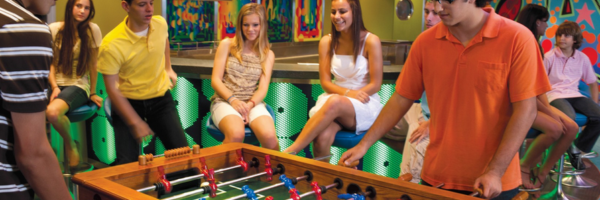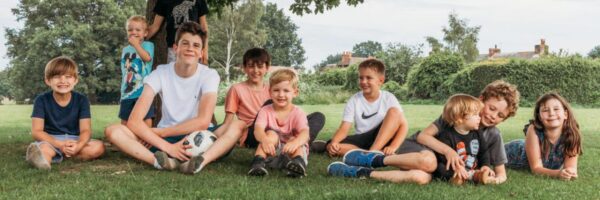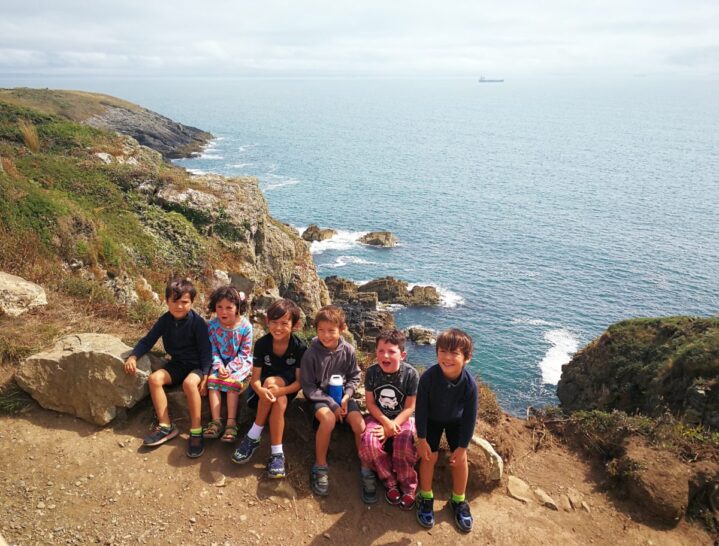
The natural beauty that is Wales
It wasn’t a long drive from tiny Shrewley, England to St. Davids, Wales – a smidgen over 200 miles – but the fastest route (via Bristol, Cardiff and Swansea) didn’t appeal to me. Instead, we left the M5 near Worcester and cut Southwest through the heart of Wales along pleasant, uncrowded rural roads. We saw signs advertising speed shearing contests, pick-your-own fruit orchards, cattle ranches and farm shops. You could really smell Wales’ dairy air. Wales is the West Virginia of the UK, the butt of a thousand sheep jokes, a mountainous land of somewhat odd people speaking a strange tongue. Though Wales has been part of the British Empire since Edward I conquered it in 1282, Wales’ uniqueness has always made it seem more remote than it actually is. Like the Scots, the Welsh do not like being called British, which they associate with Englishness. The Prince of Wales, by the way, is just a title for the heir apparent to the crown. Pasty Prince Charles is not the least bit Welsh.
Perhaps it was only my imagination, but the scenery seemed to become more gorgeous as soon as we crossed the unmarked border. The countryside was greener, the hills higher and the sheep fluffier. We had nearly missed the humble sign welcoming us to Cymru – which is both Welsh for Wales and the perfect introduction to the language’s un pronounceability. When we encountered traffic, it was usually caused by giant, lumbering tractors or trucks pulling huge loads of hay that showered the road with golden streamers. Speaking of hay, we passed near Hay-on-Wye, the little town that has become internationally famous (among bibliophiles like me, at least) for its ever-expanding Literature and Arts Festival. Previous guest speakers included Arthur Miller, Salman Rushdie, John Updike, Stephen Hawking and Maya Angelou, though I think my kids would have been far more interested in the 2019 programme, featuring Julia Donaldson of “Gruffalo” fame.
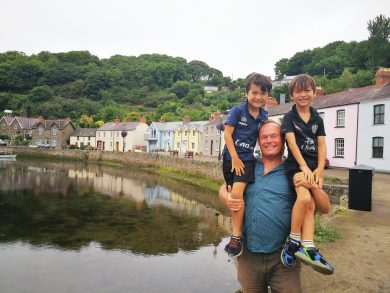
Soon, we could see the unmistakable and oddly inorganic shapes of the Brecon Beacons rising above the farms and villages. Treeless and trapezoidal, the Beacons looked as if they had been airlifted from Iceland. I made a silent promise to myself to return and walk those magnificent ridges another time. And then the road began diving and twisting through emerald tunnels of the lushest, most magical forest. Even the English say it rains a lot in Wales. We hit the coast, the fog and the rain at Newgale – a wide, sandy beach with a humped embankment of round stones between it and the highway. I assumed that the barrier had been constructed to protect the highway and the hamlet from storm surge. In fact, the stones had been deposited there by a freakish storm in 1859. The water looked ice-cold, but a few madmen had braved the churning waves to kite surf.
This was the famously rugged and beautiful Pembrokeshire Coast. If Wales is shaped like a pig’s head, then the Pembrokeshire Coast is the tip of its snout. And what a fine snout it is! Wending from Amroth Castle to St. Dogmaels around wide St. Brides Bay, the 186 mile Pembrokeshire Coast Path (“which covers almost every kind of maritime landscape” according to the official website) is one of the finest walks in Britain. Just beyond Newgale we passed above the pretty harbour town of Solva, its fog-blurred fishing boats stranded by the tide. And then we were in St. Davids, famous both for being the UK’s smallest parish and for its location at the Westernmost point of Wales, just 50 miles from the Irish coast. Popular with tourists for its history, nearby trails and wildlife tours, St. Davids’ population surged in the summer, which people confidently informed me was now. Noah and Akela were waiting for us at the entrance to their street, Ffynnon Wen. Tai rolled down the window and shouted “Noah! Noah!” Suddenly, our car was electric with excited boys. I parked the car and they rushed out, hugged Noah, and followed him inside, chattering. Noah’s home was small and cosy, one of a half-dozen row houses in a small community at the southern edge of St. Davids.
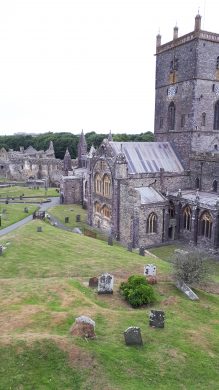 We had met Jess, her son Noah and daughter Akela at Coconut Beach on the island of Koh Rong, Cambodia in 2016. Noah had been overjoyed to have other boys to play with, and I didn’t mind including another boy in our adventurous play. Together the boys chased crabs in the tide pools, jumped off the pier into the sea, waded out to see bioluminescent plankton at night, built sandcastles on the shore and extensive domino tracks across the wooden floorboards of our resort. It was just about paradise for boys. They became fast friends. We knew that Jess and her family would be flying home from Bangkok, so Nori invited them to stay with us. They arrived a few weeks later – weary, sunburned and speckled with insect bites. When they stepped out of the elevator into our over-the-top 64th-floor apartment, Noah exclaimed “Mom! This is the nicest hotel we’ve ever stayed in!” To reciprocate, Jess had offered to put us up if we made it to Wales. So of course we did. Naturally, all the boys wanted to sleep together in the same room. So Jess generously gave Nori and I her bedroom upstairs while she and Akela slept together downstairs. Travel karma is wonderful.
We had met Jess, her son Noah and daughter Akela at Coconut Beach on the island of Koh Rong, Cambodia in 2016. Noah had been overjoyed to have other boys to play with, and I didn’t mind including another boy in our adventurous play. Together the boys chased crabs in the tide pools, jumped off the pier into the sea, waded out to see bioluminescent plankton at night, built sandcastles on the shore and extensive domino tracks across the wooden floorboards of our resort. It was just about paradise for boys. They became fast friends. We knew that Jess and her family would be flying home from Bangkok, so Nori invited them to stay with us. They arrived a few weeks later – weary, sunburned and speckled with insect bites. When they stepped out of the elevator into our over-the-top 64th-floor apartment, Noah exclaimed “Mom! This is the nicest hotel we’ve ever stayed in!” To reciprocate, Jess had offered to put us up if we made it to Wales. So of course we did. Naturally, all the boys wanted to sleep together in the same room. So Jess generously gave Nori and I her bedroom upstairs while she and Akela slept together downstairs. Travel karma is wonderful.
But it took a long time for the kids to wind down. They had been having so much fun together, six kids shrieking as they dodged four balls that bounced randomly about the trampoline. To calm them, I did a very long storytelling session: true stories from Nori and my journey to Antarctica and a funny one about my summer working on a Christmas tree farm. Jess had baked a beautiful shepherd’s pie. The house was filled with the comforting aromas of stewed vegetables. We sat and talked until midnight – about life in Wales, her struggles as a single mom, our trip so far, and our concerns about returning home to the USA. As every source told me, St. David’s is the smallest parish in the UK. But I failed to understand the importance of this fact until I stumbled upon the cathedral. Located in a grassy hollow, its imposing square bell tower wasn’t even visible from the town square or Jess’ home, both of which were less than 200 metres away.
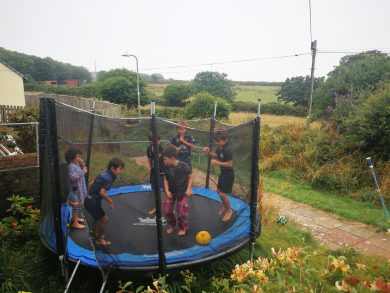 Built of grey stone, the cathedral’s massive, cruciform floor plan was comically out of proportion to St. David’s population of just 2,000. Then I got it: it can’t be a city (parish) without a cathedral; since St. David’s has a cathedral, it’s a city. Drake had joined me on the short walk to the cathedral. He’d brought a bubble wand. We both giggled as the bubbles, buffeted by unpredictable draughts, weaved between the slanted gravestones, dodged trees and rose over the encircling walls. We had contests to see whose bubble would last the longest. On Jess’ kitchen wall were a series of posters designed to help kids learn Welsh. A Celtic language related to Gaelic, Cornish and Breton, Welsh has a reputation for being impossible to learn, a vowelless exercise in throat-clearing. (In fact, 362,000 people are learning Welsh on the Duolingo language app, slightly fewer than are learning Klingon.) To be sure, the everyday words on the poster bore no resemblance to anything I’d seen before:
Built of grey stone, the cathedral’s massive, cruciform floor plan was comically out of proportion to St. David’s population of just 2,000. Then I got it: it can’t be a city (parish) without a cathedral; since St. David’s has a cathedral, it’s a city. Drake had joined me on the short walk to the cathedral. He’d brought a bubble wand. We both giggled as the bubbles, buffeted by unpredictable draughts, weaved between the slanted gravestones, dodged trees and rose over the encircling walls. We had contests to see whose bubble would last the longest. On Jess’ kitchen wall were a series of posters designed to help kids learn Welsh. A Celtic language related to Gaelic, Cornish and Breton, Welsh has a reputation for being impossible to learn, a vowelless exercise in throat-clearing. (In fact, 362,000 people are learning Welsh on the Duolingo language app, slightly fewer than are learning Klingon.) To be sure, the everyday words on the poster bore no resemblance to anything I’d seen before:
Dog = Ci City = Ddinas Ocean = Cefnfor Eat = Bwyta
Was dog pronounced ‘see’, ‘key’ or ‘chee’? I had no idea! That said, Welsh is apparently both completely phonetic and regular. In other words, once you learn the correct sounds of the letters or letter combinations, you can pronounce every word in Welsh perfectly – if roaring drunk. And while less than 20% of the 3.2 million inhabitants of Wales actually speak Welsh, the language (and therefore the culture) is, improbably, staging a comeback, bolstered by an expanded school curriculum, new technology (like Duolingo) and national pride. The weather planned our days in Wales. The adults did nothing in the morning except eat breakfast and gab while the kids played. Then, when some light appeared to be piercing the thick comforter of fog, we stared out the back window, ready to rush outside if the sun broke through. At two in the afternoon on our final afternoon in Wales, we saw our opportunity. After bundling the kids in their warmest clothes, both families walked south of St. Davids to the ruins of St. Non’s Chapel. Here we intersected with the Pembrokeshire Coast Path, which skirted the edge of the deeply indented cliffs.
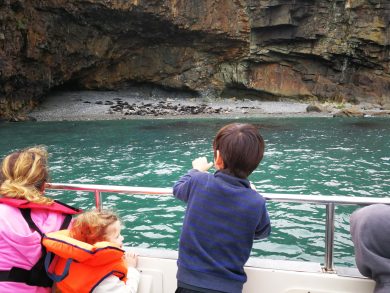 The views of the coast and St. Brides Bay were magnificent. “We’ve got to come back to Wales and do the whole walk,” I told Nori. But there were no fences or guardrails between the trail and a plunge to the rocks below. Heedless of the danger, the boys were chasing each other, throwing rocks into the ocean and even belly-bumping. “Boys! Please stop that!” Jess yelled, with no discernible impact. I don’t think they even heard her. She turned to me. “There was a boy, an American boy, who fell over these cliffs last month and is still in a coma.” OK, that worried me. I caught up with the boys and dragged them away from the cliffs I wanted to do something nice for Jess and her family. So I booked a boat tour of nearby Ramsay Island, a wildlife reserve that was home to huge numbers of seabirds as well as sea lions. I just hoped the weather would hold! It had been foggy and overcast the whole time we were in Wales. Our tour boat was open decked with bench seats. If it rained, we’d get soaked.
The views of the coast and St. Brides Bay were magnificent. “We’ve got to come back to Wales and do the whole walk,” I told Nori. But there were no fences or guardrails between the trail and a plunge to the rocks below. Heedless of the danger, the boys were chasing each other, throwing rocks into the ocean and even belly-bumping. “Boys! Please stop that!” Jess yelled, with no discernible impact. I don’t think they even heard her. She turned to me. “There was a boy, an American boy, who fell over these cliffs last month and is still in a coma.” OK, that worried me. I caught up with the boys and dragged them away from the cliffs I wanted to do something nice for Jess and her family. So I booked a boat tour of nearby Ramsay Island, a wildlife reserve that was home to huge numbers of seabirds as well as sea lions. I just hoped the weather would hold! It had been foggy and overcast the whole time we were in Wales. Our tour boat was open decked with bench seats. If it rained, we’d get soaked.
 Our luxuriantly bearded captain looked like a Viking marauder. I chuckled as he demonstrated the use of the lifejackets. Were there safety briefings on Viking longships, I wondered? “In the fairly likely event that we capsize in rough seas, your oars can be used as a flotation device. Please flee the boat by leaping over the side. Make sure to remove your boots and leave all weapons, helmets and shields behind. Thank you for sailing with Viking Line – now everyone can pillage!” First, we motored out beyond the channel, where we encountered dolphins leaping out of big, slow-moving ocean waves. Some passengers looked very nervous. Those waves looked high enough to swamp the ship, but they only lifted and lowered us gently. Then we turned back and approached The Bitches, a hull-ripping line of toothlike rocks with the current racing between them. Next, we stopped for a while to watch a colony of extremely fat sea lions rolling and barking at each other. Noah had a huge smile on his face.
Our luxuriantly bearded captain looked like a Viking marauder. I chuckled as he demonstrated the use of the lifejackets. Were there safety briefings on Viking longships, I wondered? “In the fairly likely event that we capsize in rough seas, your oars can be used as a flotation device. Please flee the boat by leaping over the side. Make sure to remove your boots and leave all weapons, helmets and shields behind. Thank you for sailing with Viking Line – now everyone can pillage!” First, we motored out beyond the channel, where we encountered dolphins leaping out of big, slow-moving ocean waves. Some passengers looked very nervous. Those waves looked high enough to swamp the ship, but they only lifted and lowered us gently. Then we turned back and approached The Bitches, a hull-ripping line of toothlike rocks with the current racing between them. Next, we stopped for a while to watch a colony of extremely fat sea lions rolling and barking at each other. Noah had a huge smile on his face.
The seaward side of Ramsay Island was rugged and elemental, with tall, guano-stained cliffs plunging into the angry water. The ceaseless waves had burrowed deep caverns that looked like sea monsters’ lairs. Unafraid, Viking captain piloted our boat through a narrow, curving channel between the island and several sea stacks. It was an impressive manoeuvre, but I seemed to be the only one who noticed: most of the passengers were huddled against the cold and stinging spray. As the boat rounded Ramsay’s northern cape, Logan spotted a crow like bird with a brilliant red beak flying low over the grassy slope. “Nice one!” exclaimed our guide. “That’s a black chough, a very rare bird.” Logan looked very pleased with himself. Recently, his obsession with birds had been replaced by an obsession with the backstories of video game characters. I missed the birds.

Our next big goal was Edinburgh, Scotland. We could have taken the motorways and blasted there in eight hours, but we were in no rush. I hoped to see mountainous northern Wales and perhaps even hike a bit of Snowdon, Wales’ highest peak at 1,085 metres. Blogs said that the roundtrip walk took 5-7 hours. Perhaps we could hike up and take the Snowdon Mountain Railway down? Noah cried as he said goodbye to our boys, just as he had in Koh Rong and in Bangkok. It would be hard going back to just one boy in the house when there had been five. “Come visit us in California!” Tai offered. We left St. Davids shrouded in dense fog. Thirty minutes later, the rain started. As we felt our way north past the coastal towns of Fishguard, Cardigan, Plwmp, Llanarth, Ddighwdd, Aberaeron, Llanrhystud and Aberystwyth (all real places except one!) the Welsh summer intensified – it was raining cathod a chŵn. We had no hope of seeing the mountains; we could barely see the road.


